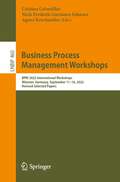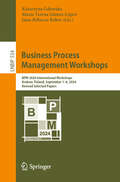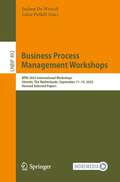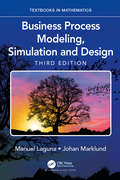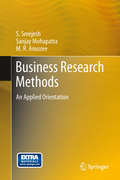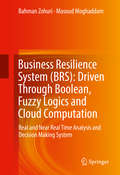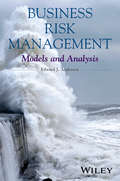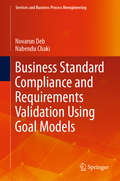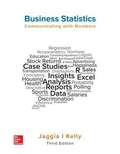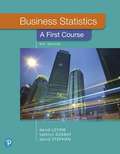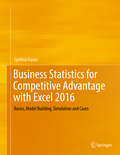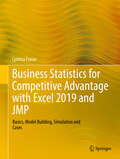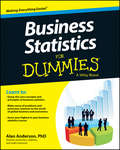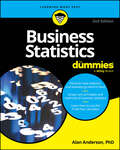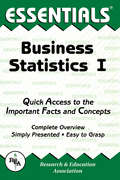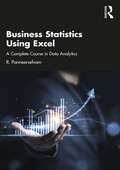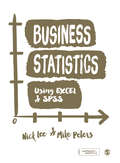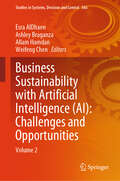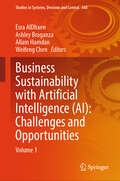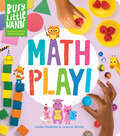- Table View
- List View
Business Process Management Workshops: BPM 2022 International Workshops, Münster, Germany, September 11–16, 2022, Revised Selected Papers (Lecture Notes in Business Information Processing #460)
by Cristina Cabanillas Niels Frederik Garmann-Johnsen Agnes KoschmiderThis book constitutes revised papers from the International Workshops held at the 20th International Conference on Business Process Management, BPM 2022, in Münster, Germany, during September 11-15, 2022. Papers from the following workshops are included:· 6th International Workshop on Artificial Intelligence for Business Process Management (AI4BPM 2022)· 6th International Workshop on Business Processes Meet Internet-of-Things (BP-Meet-IoT 2022)· 18th International Workshop on Business Process Intelligence (BPI 2022)· 2nd International Workshop on Business Process Management and Routine Dynamics (BPM&RD 2022)· 14th International Workshop on Social and Human Aspects of Business Process Management (BPMS2 2022) · 1st International Workshop on Data-Driven Business Process Optimization (BPO 2022) · 10th International Workshop on DEClarative, DECision and Hybrid approaches to processes (DEC2H 2022) · 1st International Workshop on Natural Language Processing for Business Process Management (NLP4BPM 2022) Each of the eight workshops focused on particular aspects of business process management. Overall, after a thorough review process, there were 23 full and 3 short papers selected from a total of 51 submissions. Only one of the short papers is included in the proceedings.
Business Process Management Workshops: BPM 2024 International Workshops, Krakow, Poland, September 1–6, 2024, Revised Selected Papers (Lecture Notes in Business Information Processing #534)
by Katarzyna Gdowska María Teresa Gómez-López Jana-Rebecca RehseThis book constitutes revised papers from the International Workshops held at the 22nd International Conference on Business Process Management, BPM 2024, in Krakow, Poland, during September 2024. Each of the workshops focused on particular aspects of business process management. Overall, after a thorough review process, 28 full papers and 2 short papers were selected from a total of 64 submissions. Papers from the following workshops are included: 8th International Workshop on Artificial Intelligence for Business Process Management (AI4BPM 2024) 3rd International Workshop on Data-Driven Business Process Optimization (BPO 2024) 8th International Workshop on Business Processes Meet Internet-of-Things (BP-Meet-IoT 2024) 17th International Workshop on Social and Human Aspects of Business Process Management (BPMS2 2024) 3rd International Workshop on Natural Language Processing for Business Process Management (NLP4BPM 2024) International Workshop on Object-centric Processes from A to Z (OBJECTS 2024) 2nd International Workshop on Change, Drift, and Dynamics of Organizational Processes (ProDy 2024) 1st International Workshop on Managing Process Innovation and Value Creation in the Era of Digital Transformation (Innov8BPM 2024)
Business Process Management Workshops: BPM 2023 International Workshops, Utrecht, The Netherlands, September 11–15, 2023, Revised Selected Papers (Lecture Notes in Business Information Processing #492)
by Jochen De Weerdt Luise PufahlThis book constitutes revised papers from the International Workshops held at the 21st International Conference on Business Process Management, BPM 2023, in Utrecht, The Netherlands, during September 2023.Papers from the following workshops are included:• 7th International Workshop on Artificial Intelligence for Business Process Management (AI4BPM 2023)• 7th International Workshop on Business Processes Meet Internet-of-Things (BP-Meet-IoT 2023)• 19th International Workshop on Business Process Intelligence (BPI 2023)• 16th International Workshop on Social and Human Aspects of Business Process Management (BPMS2 2023)• 2nd International Workshop on Data-Driven Business Process Optimization (BPO 2023)• 11th International Workshop on Declarative, Decision and Hybrid Approaches to Processes (DEC2H 2023)• 1st International Workshop on Digital Twins for Business Processes (DT4BP 2023)• 1st International Workshop on Formal Methods for Business Process Management (FM-BPM 2023) • 2nd International Workshop on Natural Language Processing for Business Process Management (NLP4BPM 2023)• 1st International Workshop on Object-Centric Processes from A to Z (OBJECTS 2023)• 3rd International Workshop on Change, Drift, and Dynamics of Organizational Processes (ProDy 2023) Each of the workshops focused on particular aspects of business process management. Overall, after a thorough review process, 42 full papers were selected from a total of 86 submissions.
Business Process Modeling, Simulation and Design (Textbooks in Mathematics)
by Manuel Laguna Johan MarklundBusiness Process Modeling, Simulation and Design, Third Edition provides students with a comprehensive coverage of a range of analytical tools used to model, analyze, understand, and ultimately design business processes. The new edition of this very successful textbook includes a wide range of approaches such as graphical flowcharting tools, cycle time and capacity analyses, queuing models, discrete-event simulation, simulation-optimization, and data mining for process analytics. While most textbooks on business process management either focus on the intricacies of computer simulation or managerial aspects of business processes, this textbook does both. It presents the tools to design business processes and management techniques on operating them efficiently. The book focuses on the use of discrete event simulation as the main tool for analyzing, modeling, and designing effective business processes. The integration of graphic user-friendly simulation software enables a systematic approach to create optimal designs.
Business Research Methods: An Applied Orientation
by Sanjay Mohapatra S Sreejesh M R AnusreeSince research is best learned by doing, this book emphasizes a hands-on, do-it yourself approach. The readers have many opportunities to see how business researches affect and support management decision. The book used a case study approach for all the chapters with interactive videos. The book gave emphasis to quantitative data analysis using a software program, IBM SPSS 20.0. The data analysis chapters illustrate in detail each step in running the software programs. The software programs files are provided for all data sets: outputs, demonstration movies, and screen captures are on the Website. This book provides students most extensive help available to learn quantitative data analysis using SPSS. Thus, the authors prepared this textbook and all the additional materials to help the students to understand the functional principles of business research and how to apply them in real-life situations.
Business Resilience System (BRS) (BRS): Real and Near Real Time Analysis and Decision Making System
by Bahman Zohuri Masoud MoghaddamThis book provides a technical approach to a Business Resilience System with its Risk Atom and Processing Data Point based on fuzzy logic and cloud computation in real time. Its purpose and objectives define a clear set of expectations for Organizations and Enterprises so their network system and supply chain are totally resilient and protected against cyber-attacks, manmade threats, and natural disasters. These enterprises include financial, organizational, homeland security, and supply chain operations with multi-point manufacturing across the world. Market shares and marketing advantages are expected to result from the implementation of the system. The collected information and defined objectives form the basis to monitor and analyze the data through cloud computation, and will guarantee the success of their survivability's against any unexpected threats. This book will be useful for advanced undergraduate and graduate students in the field of computer engineering, engineers that work for manufacturing companies, business analysts in retail and e-Commerce, and those working in the defense industry, Information Security, and Information Technology.
Business Risk Management
by Edward J. AndersonA comprehensive and accessible introduction to modern quantitative risk management.The business world is rife with risk and uncertainty, and risk management is a vitally important topic for managers. The best way to achieve a clear understanding of risk is to use quantitative tools and probability models. Written for students, this book has a quantitative emphasis but is accessible to those without a strong mathematical background.Business Risk Management: Models and AnalysisDiscusses novel modern approaches to risk managementIntroduces advanced topics in an accessible mannerIncludes motivating worked examples and exercises (including selected solutions)Is written with the student in mind, and does not assume advanced mathematicsIs suitable for self-study by the manager who wishes to better understand this important field. Aimed at postgraduate students, this book is also suitable for senior undergraduates, MBA students, and all those who have a general interest in business risk.
Business Standard Compliance and Requirements Validation Using Goal Models (Services and Business Process Reengineering)
by Nabendu Chaki Novarun DebThis book discusses enterprise hierarchies, which view a target system with varying degrees of abstraction. These requirement refinement hierarchies can be represented by goal models. It is important to verify that such hierarchies capture the same set of rationales and intentions and are in mutual agreement with the requirements of the system being designed. The book also explores how hierarchies manifest themselves in the real world by undertaking a data mining exercise and observing the interactions within an enterprise. The inherent sequence-agnostic property of goal models prevents requirement analysts from performing compliance checks in this phase as compliance rules are generally embedded with temporal information. The studies discussed here seek to extract finite state models corresponding to goal models with the help of model transformation. The i*ToNuSMV tool implements one such algorithm to perform model checking on i* models. In turn, the AFSR framework provides a new goal model nomenclature that associates semantics with individual goals. It also provides a reconciliation machinery that detects entailment or consistency conflicts within goal models and suggests corrective measures to resolve such conflicts. The authors also discuss how the goal maintenance problem can be mapped to the state-space search problem, and how A* search can be used to identify an optimal goal model configuration that is free from all conflicts. In conclusion, the authors discuss how the proposed research frameworks can be extended and applied in new research directions. The GRL2APK framework presents an initiative to develop mobile applications from goal models using reusable code component repositories.
Business Statistics
by Robert DonnellyRobert Donnelly's Business Statistics eliminates the intimidation factor from learning statistics for business. The Second Edition maintains Donnelly's successful straightforward, conversational approach that explains each concept and why it is important directly to students. Through an abundance of comments that clarify specific topics, a variety of applications, and Your Turn practice throughout each chapter, students see business statistics in action-both in the classroom and in the world around them.
Business Statistics: A Decision-Making Approach (8th edition)
by David F. Groebner Patrick W. Shannon Phillip C. Fry Kent D. SmithA direct approach to business statistics, ordered in a signature step-by-step framework. Business Statistics uses a direct approach that consistently presents concepts and techniques in way that benefits readers of all mathematical backgrounds. This text also contains engaging business examples to show the relevance of business statistics in action. The eighth edition provides even more learning aids to help readers understand the material.
Business Statistics: Communicating With Numbers
by Sanjiv Jaggia Alison KellyThe third edition of Business Statistics: Communicating with Numbers provides a unique, innovative, and engaging learning experience for students studying Business Statistics. It is an intellectually stimulating, practical, and visually attractive textbook, from which students can learn and instructors can teach. Throughout the book, the authors have presented the material in an accessible way by using timely business applications to which students can relate. Although the text is application-oriented, it is also mathematically sound and uses notation that is generally accepted for the topic being covered.
Business Statistics: A First Course
by David M. Levine Kathryn A. Szabat David F. StephanStatistics is essential for all business majors, and Business Statistics: A First Course helps students see the role statistics will play in their own careers by providing examples drawn from all functional areas of business. Guided by the principles set forth by major statistical and business science associations (ASA and DSI), plus the authors’ diverse experiences, the 8th Edition continues to innovate and improve the way this course is taught to all students. With new examples, case scenarios, and problems, the text continues its tradition of focusing on the interpretation of results, evaluation of assumptions, and discussion of next steps that lead to data-informed decision making. The authors feel that this approach, rather than a focus on manual calculations, better serves students in their future careers. This brief offering, created to fit the needs of a one-semester course, is part of the established Berenson/Levine series.
Business Statistics for Competitive Advantage with Excel 2010: Basics, Model Building, Simulation and Cases
by Cynthia FraserExceptional managers know that they can create competitive advantages by basing decisions on performance response under alternative scenarios. To create these advantages, managers need to understand how to use statistics to provide information on performance response under alternative scenarios. This updated edition of the popular text helps business students develop competitive advantages for use in their future careers as decision makers. Students learn to build models using logic and experience, produce statistics using Excel 2010 with shortcuts, and translate results into implications for decision makers. The author emphasizes communicating results effectively in plain English and with compelling graphics in the form of memos and PowerPoints. Statistics, from basics to sophisticated models, are illustrated with examples using real data such as students will encounter in their roles as managers. A number of examples focus on business in emerging global markets with particular emphasis on China and India. Results are linked to implications for decision making with sensitivity analyses to illustrate how alternate scenarios can be compared. Chapters include screenshots to make it easy to conduct analyses in Excel 2010 with time-saving shortcuts expected in the business world. PivotTables and PivotCharts, used frequently in businesses, are introduced from the start. Monte Carlo simulation is introduced early, as a tool to illustrate the range of possible outcomes from decision makers' assumptions and underlying uncertainties. Model building with regression is presented as a process, adding levels of sophistication, with chapters on multicollinearity and remedies, forecasting and model validation, autocorrelation and remedies, indicator variables to represent segment differences, and seasonality, structural shifts or shocks in time series models. Special applications in market segmentation and portfolio analysis are offered, and an introduction to conjoint analysis is included. Nonlinear models are motivated with arguments of diminishing or increasing marginal response, and a chapter on logit regression models introduces models of market share or proportions. The Second Edition includes more explanation of hypothesis tests and confidence intervals, how t, F, and chi square distributions behave. The Data Files, Solution Files, and Chapter PowerPoints: The data files for text examples, cases, lab problems and assignments are stored on Blackboard and may be accessed using this link:https://blackboard.comm.virginia.edu/webapps/portal/frameset.jsp Instructors can gain access to the files, as well as solution files and chapter PowerPoints by registering on the Springer site: http://www.springer.com/statistics/business%2C+economics+%26+finance/book/978-1-4419-9856-9?changeHeader Business people can gain access to the files by emailing the author cfg8q@virginia.edu. https://blackboard.comm.virginia.edu/webapps/portal/frameset.jsp Instructors can gain access to the files, as well as solution files and chapter PowerPoints by registering on the Springer site: http://www.springer.com/statistics/business%2C+economics+%26+finance/book/978-1-4419-9856-9?changeHeader Business people can gain access to the files by emailing the author cfg8q@virginia.edu.
Business Statistics for Competitive Advantage with Excel 2019 and JMP: Basics, Model Building, Simulation and Cases
by Cynthia FraserThe revised Fifth Edition of this popular textbook is redesigned with Excel 2019 and the new inclusion of interactive, user-friendly JMP to encourage business students to develop competitive advantages for use in their future careers. Students learn to build models, produce statistics, and translate results into implications for decision makers. The text features new and updated examples and assignments, and each chapter discusses a focal case from the business world which can be analyzed using the statistical strategies and software provided in the text. Paralleling recent interest in climate change and sustainability, new case studies concentrate on issues such as the impact of drought on business, automobile emissions, and sustainable package goods. The book continues its coverage of inference, Monte Carlo simulation, contingency analysis, and linear and nonlinear regression. A new chapter is dedicated to conjoint analysis design and analysis, including complementary use of regression and JMP.For access to accompanying data sets, please email author Cynthia Fraser at cfg8q@virginia.edu.
Business Statistics for Competitive Advantage with Excel and JMP: Basics, Model Building, Simulation, and Cases
by Cynthia FraserThis book is the latest title of the popular Excel textbook; redesigned, while including interactive, user-friendly JMP to encourage business students to develop competitive advantages for use in their future careers. How can performance outcome drivers be identified? How can performance outcomes be forecast? Use of regression, conjoint analysis, Monte Carlo simulation provide answers and solutions for specific scenarios. Students learn to build models, produce statistics, and translate results into implications for decision makers.The text features new and updated examples and assignments, and each chapter discusses a focal case from the business world which can be analyzed using the statistical strategies and software provided in the text. Paralleling recent interest in climate change and sustainability, new case studies concentrate on issues such as the impact of drought on business, automobile emissions, and sustainable package goods.The book continues its coverage of inference, Monte Carlo simulation, contingency analysis, and linear and nonlinear regression. A new chapter is dedicated to conjoint analysis design and analysis, including complementary use of regression and JMP.
Business Statistics For Dummies
by Alan AndersonScore higher in your business statistics course? Easy.Business statistics is a common course for business majors and MBA candidates. It examines common data sets and the proper way to use such information when conducting research and producing informational reports such as profit and loss statements, customer satisfaction surveys, and peer comparisons.Business Statistics For Dummies tracks to a typical business statistics course offered at the undergraduate and graduate levels and provides clear, practical explanations of business statistical ideas, techniques, formulas, and calculations, with lots of examples that shows you how these concepts apply to the world of global business and economics.Shows you how to use statistical data to get an informed and unbiased picture of the marketServes as an excellent supplement to classroom learningHelps you score your highest in your Business Statistics courseIf you're studying business at the university level or you're a professional looking for a desk reference on this complicated topic, Business Statistics For Dummies has you covered.
Business Statistics For Dummies
by Alan AndersonMake some headway in the notoriously tough subject of business statistics Business Statistics For Dummies helps you understand the core concepts and principles of business statistics, and how they relate to the business world. This book tracks to a typical introductory course offered at the undergraduate, so you know you’ll find all the content you need to pass your class and get your degree. You’ll get an introduction to statistical problems and processes common to the world of global business and economics. Written in clear and simple language, Business Statistics For Dummies gives you an introduction to probability, sampling techniques and distributions, and drawing conclusions from data. You’ll also discover how to use charts and graphs to visualize the most important properties of a data set. Grasp the core concepts, principles, and methods of business statistics Learn tricky concepts with simplified explanations and illustrative graphs See how statistics applies in the real world, thanks to concrete examples Read charts and graphs for a better understanding of how businesses operateBusiness Statistics For Dummies is a lifesaver for students studying business at the college level. This guide is also useful for business professionals looking for a desk reference on this complicated topic.
Business Statistics I Essentials (Essentials Study Guides #1)
by Louise ClarkREA's Essentials provide quick and easy access to critical information in a variety of different fields, ranging from the most basic to the most advanced. As its name implies, these concise, comprehensive study guides summarize the essentials of the field covered. Essentials are helpful when preparing for exams, doing homework and will remain a lasting reference source for students, teachers, and professionals. Business Statistics I includes descriptive statistics, introduction to probability, probability distributions, sampling and sampling distributions, interval estimation, and hypothesis testing.
Business Statistics Using Excel
by R. PanneerselvamA comprehensive and engaging textbook that presents the fundamentals of statistical analysis using Excel and its application in business. For beginners, both statistics and Excel can be intimidating topics to grasp. This textbook promises to be an easy solution that offers an introduction to the use of Excel in business statistics. The author provides step-by-step instructions on how to use Excel, beginning from the very basics and leading up to solving complicated statistical problems. Filled with screenshots illustrating each step, this book provides detailed explanations on how to use the different statistical functions that Excel offers and their application in the world of business. It shows readers how Excel is an invaluable tool in a manager's toolbox and how it can be used for effective and efficient decision-making. Business Statistics Using Excel would be a valuable companion for both students and practising managers who want to improve their skills in data analytics. Key Features: • Contains more than 100 solved examples to explain key statistical problems • Exhaustive coverage of current syllabi of business statistics of major institutes and universities • Includes supplementary resources on advance topics such as statistics using R • Extensive review exercises at the end of each chapter to ensure maximum retention
Business Statistics Using Excel: A Complete Course in Data Analytics
by R. PanneerselvamThis book gives readers a hands-on understanding of Excel-assisted statistical techniques to take effective business decisions. It showcases applications of the tools and techniques of statistics for analysing business data from the domain of business statistics. The volume provides an exhaustive introduction to the application of statistics in solving business problems and implementing data analytics for effective decision making in all kinds of business situations around the world. With an emphasis on simplicity in presentation of concepts of statistical methods and associated Excel functions, the volume explores the implementation of Excel functions through well-defined sequences of steps. It covers an array of key topics which include Discussions on real-world problems, decision support systems, scope of business statistics, types, and steps of research; Introduction to Excel and its mathematical and preliminary statistical functions; usage of different types of average functions; mean, median, and mode functions; measures of variation; measures of skewness of Excel; In-depth discussions on probability distributions, sampling distributions, testing of hypothesis, chi-square test, non-parametric tests of Excel; Extensive coverage on correlation and covariance, forecasting, analysis of variance, charts in Excel; and Analysis of the concept of linear programming, problem formulations, and techniques of linear programming, followed by the application in Excel. Comprehensive in scope and simple in approach, this book will be key for students and researchers of business studies, business administration, economics, finance, commerce, data analytics/science, and computer science. This will also serve as useful guidebook for business executives and working professionals across the globe.
Business Statistics Using EXCEL and SPSS
by Nick Lee Mike Peters'Takes the challenging and makes it understandable. The book contains useful advice on the application of statistics to a variety of contexts and shows how statistics can be used by managers in their work.' - Dr Terri Byers, Assistant Professor, University Of New Brunswick, Canada A book about introductory quantitative analysis, the authors show both how and why quantitative analysis is useful in the context of business and management studies, encouraging readers to not only memorise the content but to apply learning to typical problems. Fully up-to-date with comprehensive coverage of IBM SPSS and Microsoft Excel software, the tailored examples illustrate how the programmes can be used, and include step-by-step figures and tables throughout. A range of ‘real world’ and fictional examples, including "The Ballad of Eddie the Easily Distracted" and "Esha's Story" help bring the study of statistics alive. A number of in-text boxouts can be found throughout the book aimed at readers at varying levels of study and understanding Back to Basics for those struggling to understand, explain concepts in the most basic way possible - often relating to interesting or humorous examples Above and Beyond for those racing ahead and who want to be introduced to more interesting or advanced concepts that are a little bit outside of what they may need to know Think it over get students to stop, engage and reflect upon the different connections between topics A range of online resources including a set of data files and templates for the reader following in-text examples, downloadable worksheets and instructor materials, answers to in-text exercises and video content compliment the book. An ideal resource for undergraduates taking introductory statistics for business, or for anyone daunted by the prospect of tackling quantitative analysis for the first time.
Business Statistics Using EXCEL and SPSS
by Nick Lee Mike Peters'Takes the challenging and makes it understandable. The book contains useful advice on the application of statistics to a variety of contexts and shows how statistics can be used by managers in their work.' - Dr Terri Byers, Assistant Professor, University Of New Brunswick, Canada A book about introductory quantitative analysis, the authors show both how and why quantitative analysis is useful in the context of business and management studies, encouraging readers to not only memorise the content but to apply learning to typical problems. Fully up-to-date with comprehensive coverage of IBM SPSS and Microsoft Excel software, the tailored examples illustrate how the programmes can be used, and include step-by-step figures and tables throughout. A range of 'real world' and fictional examples, including "The Ballad of Eddie the Easily Distracted" and "Esha's Story" help bring the study of statistics alive. A number of in-text boxouts can be found throughout the book aimed at readers at varying levels of study and understanding Back to Basics for those struggling to understand, explain concepts in the most basic way possible - often relating to interesting or humorous examples Above and Beyond for those racing ahead and who want to be introduced to more interesting or advanced concepts that are a little bit outside of what they may need to know Think it over get students to stop, engage and reflect upon the different connections between topics A range of online resources including a set of data files and templates for the reader following in-text examples, downloadable worksheets and instructor materials, answers to in-text exercises and video content compliment the book. An ideal resource for undergraduates taking introductory statistics for business, or for anyone daunted by the prospect of tackling quantitative analysis for the first time.
Business Sustainability with Artificial Intelligence: Volume 2 (Studies in Systems, Decision and Control #566)
by Esra AlDhaen Ashley Braganza Allam Hamdan Weifeng ChenThis book covers different technological and business-related issues including ethical use and cultural sensitivity of data used in businesses, managing data privacy and protection, governance standards for digital transformation, executive leadership strategic decisions, and business innovation and sustainability. With the recent development of artificial intelligence (AI), businesses are urged to consider innovation while applying digital transformation. Depending on the nature of the businesses, it is found that innovative digital transformation is required with the use of artificial intelligence. However, the future of AI in businesses is yet unclear, the question is it true that without digital transformation businesses are no longer sustainable? Researchers argue that digital transformation could be an opportunity for business to create a global brand however several implications and challenges should be considered including governance and responsible digital management. This book explores how businesses could benefit from AI and leverage technologies to sustain businesses. The book is authored by leading experts in the field of AI, digitalization, and business innovation and sustainability; the author’s diversity reflects quality of research with high level of impact in the research topic. It is written in accessible language that makes it easy for business leaders, researchers, policymakers, and anyone interested in the future of business development to understand the complex concepts and ideas presented in the book. This book provides insight for executive leaders in setting new innovative strategies toward leveraging AI in business at different levels of operations to support business sustainability. The book provides different theoretical and practical practices and case studies that could be used as a guideline for policy making and devising innovative directions.
Business Sustainability with Artificial Intelligence: Volume 1 (Studies in Systems, Decision and Control #568)
by Esra AlDhaen Ashley Braganza Allam Hamdan Weifeng ChenWith the recent development of Artificial Intelligence (AI), businesses are urged to consider innovation while applying digital transformation. Depending on the nature of the businesses, it is found that innovative digital transformation is required with the use of Artificial Intelligence. However, the future of AI in businesses is yet unclear, the question is it true that without digital transformation businesses are no longer sustainable? Researchers argue that digital transformation could be an opportunity for business to create a global brand however several implications and challenges should be considered including governance and responsible digital management. This book explores how businesses could benefit from AI and leverage technologies to sustain businesses, and the book covers different technological and business-related issues including ethical use and cultural sensitivity of data used in businesses, managing data privacy and protection, governance standards for digital transformation, executive leadership strategic decisions, business innovation, and sustainability. The book is authored by leading experts in the field of AI, digitalization, and business innovation and sustainability, and the author’s diversity reflects quality of research with high level of impact in the research topic. It is written in accessible language that makes it easy for business leaders, researchers, policymakers, and anyone interested in the future of business development to understand the complex concepts and ideas presented in the book. This book provides insight for executive leaders in setting new innovative strategies toward leveraging AI in business at different levels of operations to support business sustainability. The book provides different theoretical and practical practices and case studies that could be used as a guideline for policy making and devising innovative directions.
Busy Little Hands: Learning Activities for Preschoolers (Busy Little Hands)
by Linda Dauksas Jeanne WhiteIn this third book in the Busy Little Hands series, (Busy Little Hands: Art Play! and Busy Little Hands: Food Play!) preschoolers are introduced to the idea that math is everywhere, and numbers are fun! Each page features lots of bright pictures for pre-readers and each activity is designed for little mathematicians to play with numbers as they count, compare, measure, and make patterns using toys, snacks, and other items that are part of everyday life. From Counting Cars and Shape Stamping to Number Hide & Seek and Pattern Hunt, this book is packed with learning fun that will set preschoolers on the path to math success. Durable cards and stickers add hands-on learning elements.
